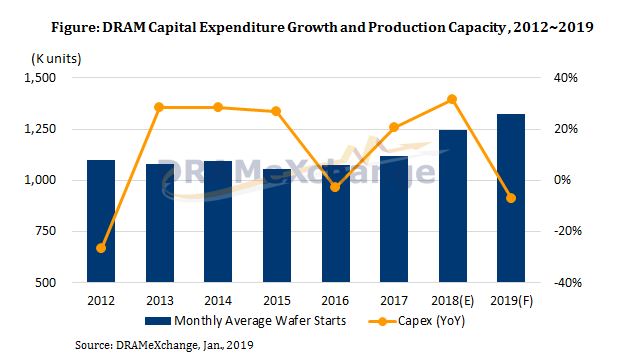DRAM Products May Experience Steeper Price Decline of 5% QoQ in 4Q18 Due to Oversupply and Weak Demand
DRAMeXchange, a division of TrendForce, reports that DRAM suppliers have been negotiating with their clients over the 4Q18 contracts towards the end of September. Looking ahead to the next quarter, DRAMeXchange expects that the quotations of DRAM products to decline by 5% QoQ, higher than the previous forecast of 1~3%. The weak quotations are mainly due to increasing bit supply yet fairly limited growth in demand, despite the coming of holiday sales season.
“DRAM products have begun to see a weak price trend since 3Q18 after the price growth of nine consecutive quarters”, says Avril Wu, senior research director of DRAMeXchange. Particularly, PC DRAM and server DRAM showed only a 1~2% price hike QoQ in the third quarter, while mobile DRAM applications witnessed a flat price trend despite the busy season. Graphics DRAM has even started to experience a price drop during the same period. On the other hand, the spot prices have been sliding since the beginning of this year and then dropped to a level lower than contract prices at the end of June. Currently, the spot prices are 10% lower than contract prices, which is an early indicator of the possible DRAM price decline in general.
Server DRAM products may see steeper price drop in the slowing DRAM market
In the server DRAM market, orders from data center customers in North America and the transition to the new server processor platform have driven up the demand. Amid the tight supply of DRAM in 1H18, the end-clients tended to secure the supply by double booking. By 3Q18, the undersupply has been eased with significantly improved order fulfillment rates, as the DRAM suppliers continue to increase the proportion of server DRAM applications in their product mixes. Looking ahead to the fourth quarter, DRAMeXchange expects the quotations to decline by 5% QoQ, higher than the previous forecast of 2%. This is because the server demand is uncertain and spot prices of DRAM products continue to fall in the channel market. Particularly, Korean DRAM manufacturers have already lowered their target prices for 4Q18.
Similar to server DRAM, the PC DRAM market also expects an oversupply and a price drop up to 5%. The price decline is larger than the previous forecast, for the shortage of Intel CPUs may lead to lower demand for notebooks and PC DRAM in a row. In terms of specialty DRAM, DRAMeXchange notes that the demand has already gone weak, together with price declines since September, because the U.S-China trade war has brought some uncertainties to the market. For 4Q18, there is a higher chance for the contract prices of specialty DRAM to decrease, even steeper than PC DRAM and server DRAM.
Mobile DRAM products also expect a weak price trend in 4Q18 although the shipments of new iPhones are expected to boost the demand. However, the market tends to be conservative about the smartphone sales due to new iPhones’ high price tag. Therefore, DRAMeXchange expects high possibilities for the oversupply of DRAM. Specifically, in 4Q18, the prices of discrete solutions may decline by around 3% QoQ, while eMCP may see up to 8% QoQ price decline due to the continuous price drop of NAND Flash.
在线留言询价

DRAM Prices Forecast to Crash in Q1

DRAM Market to See Lower Capital Expenditure and Moderated Bit Output in 2019 Due to Weak Demand

DRAM Outlook Dims for 2019
- 一周热料
- 紧缺物料秒杀
| 型号 | 品牌 | 询价 |
|---|---|---|
| RB751G-40T2R | ROHM Semiconductor | |
| MC33074DR2G | onsemi | |
| BD71847AMWV-E2 | ROHM Semiconductor | |
| TL431ACLPR | Texas Instruments | |
| CDZVT2R20B | ROHM Semiconductor |
| 型号 | 品牌 | 抢购 |
|---|---|---|
| ESR03EZPJ151 | ROHM Semiconductor | |
| TPS63050YFFR | Texas Instruments | |
| IPZ40N04S5L4R8ATMA1 | Infineon Technologies | |
| STM32F429IGT6 | STMicroelectronics | |
| BU33JA2MNVX-CTL | ROHM Semiconductor | |
| BP3621 | ROHM Semiconductor |
AMEYA360公众号二维码
识别二维码,即可关注
























